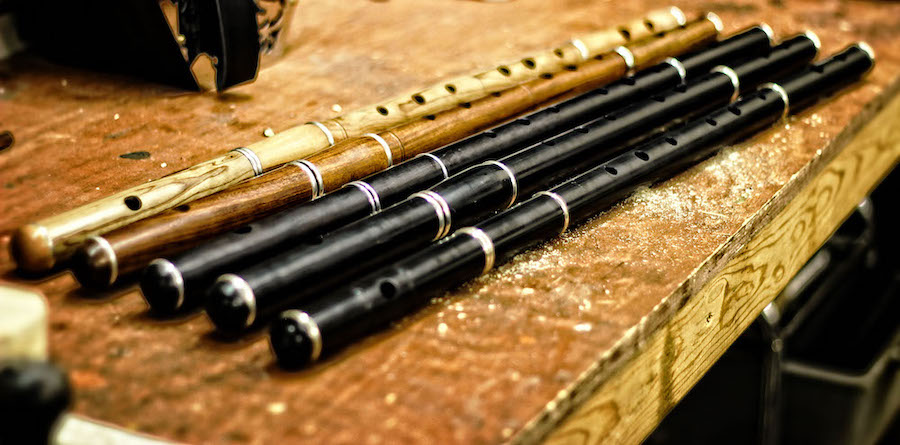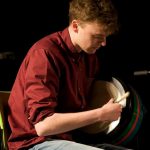
Irish Flute
Ita
L’Irish flute è un flauto traverso in legno, correntemente usato nella musica britannica e irlandese.
L’Irish flute (irlandese: fliúít Gaelach) è anche chiamato “Scottish Flute” (in Scozia) o timber flute.
I flauti traversi utilizzati nella musica celtica odierna, derivano da un piccolo numero di modelli di flauti inglesi della prima metà del XIX° secolo. I primi modelli di cui si hanno testimonianze furono costruiti da militari inglesi di stanza in Irlanda; da qui la denominazione “Irish flute” che non indica una esclusiva appartenenza dello strumento all’Irlanda: si tratta dunque di un termine generico per riferirsi allo strumento ed in particolar modo alla sua versione priva di chiavi.
Questi flauti, generalmente in re, hanno la particolarità, rispetto ai loro coetanei del resto d’Europa, di avere fori più grandi, che in genere non consentono alterazioni “in forchetta”. Questa disposizione, messa a punto dal virtuoso Inglese Charles Nicholson, dà loro un suono potente e leggermente roco, quando viene spinto. Questi flauti antichi, nella stragrande maggioranza, hanno 8 tasti per suonare le note alterate e riuscire a scendere fino al do basso.
Il fatto che in questo tipo di flauto mancano le chiavi permette di ottenere notevoli abbellimenti durante le esecuzioni come ad esempio la tecnica detta “sliding” ovvero aprire lentamente un foro, oppure il “vibrato” cioè muovere velocemente il dito sopra l’ultimo foro utilizzato (il foro sotto all’ultimo coperto per ottenere la nota desiderata), o ancora il “rolling” o il “cranning” un adattamento al flauto derivante dalla “Uilleann pipe” ed introdotta da Matt Molloy. Come si vede questo flauto risulta essere molto dinamico verso molti virtuosismi e le esecuzioni che ne risultano sono sicuramente molto più rapide e piacevoli; inoltre il calore del suono del modello in legno è incomparabile rispetto al modello classico in metallo.
Eng
The Irish flute is a conical-bore, simple-system wooden flute of the type favoured by classical flautists of the early 19th century, or to a flute of modern manufacture derived from this design (often with modifications to optimize its use in Irish Traditional Music, Scottish Traditional Music or Music of Brittany and other Celtic nations). The majority of traditional Irish flute players use a wooden, simple-system flute.
The instrument’s real spiritual home could be said to be towards the mid-west of the country. Particularly in the counties of Leitrim, Sligo and Roscommon, as well as East Galway, South Fermanagh, West Limerick and Clare.
Despite its name, it is not in fact indigenous to the country.
This instrument is a predecessor to the standard instrument that came in being in England in the the mid-1800s.
From the latter part of the 19th century, there were two main styles of large-holed flutes made by two London-based companies: Rudall & Rose and later Boosey & Co., which produced the Pratten flute devised by Robert Sidney Pratten, a prominent flautist of the 1840s and 1850s.
Simple system flutes were not made with traditional folk musicians in mind, but were adapted by amateur flautists as the simple wooden flutes were discarded by concert musicians. Belfast-born flute-maker Samuel Colin Hamilton is of the opinion that military flute and fife bands, which were widespread in Ireland in the 19th century, played a role in familiarising Irish society with the flute as an instrument that could be used in dance music. Also, an upturn in the economic conditions in Ireland from the middle of the 19th century meant that more people were able to acquire instruments.
Today, transverse “simple system Irish” flutes are being made for the playing of a variety of traditional musical styles. In the Irish tradition, the material used is most commonly wood, but also Delrin, PVC, and even bamboo is used – though wood is still by far the most popular material. These modern Irish flutes can vary in the number of added metal keys, or have no keys at all. Most are tuned using modern methods and are typically better in tune with modern instruments. All have the basic six hole diatonic design as in a tinwhistle.
Credits: wikipedia.it – connemara.it – wikipedia.com – theirishplace.com



